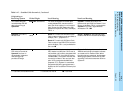
MERLIN LEGEND Communications System Release 6.1
Network Reference
555-661-150
Issue 1
August 1998
Call-Handling Scenarios
Page 2-70Network Configuration Scenarios
2
Intersystem Calling 2
This topic illustrates how different types of calls are made and received in
Scenario 3, using the extension numbers and extension equipment types shown
in Figure 2–4 on page 2–58
.
Table 2–18, page 2-71
shows how calls are made and displayed at different
recipients’ extensions within the private network. Notice how the displays vary
depending upon the type of tandem trunks and PSTN facilities that carried the
call. If the call traverses a tandem tie trunk, it displays as an outside call.
One outside call is included in Table 2–18, page 2-71
to show how PRI-ANI
information displays at the destination extension. Notice the differences among
the calls received at PassageWay Telephony Services clients:
■ The sixth call example is not an intersystem call, but is shown to illustrate
the display that results at the destination CTI link extension.
■ The last call example illustrates the use of transfer redirect across the
private network. For Release 6. and later systems, when a centralized
automated attendant transfers a call to a non-local extension, the
transferring system monitors the call to ensure that it is answered. If the
non-local extension is not available or the call is not answered within the
fixed redirect interval (32 seconds), the call stops ringing at the remote
destination and is redirected to an extension on the transferring system
(the system with the centralized VMS/AA) that is programmed to receive
redirected calls. This extension can be the first QCC queue, another
extension, or a calling group (the call is directed to an available member
and not sent to calling group coverage).
For example, the centralized VMS/AA on System L transfers a call to an
unavailable extension on System M. After the redirect interval, the call is
redirected to a QCC which is programmed to receive redirected calls on
System L. The QCC operator can then provide assistance to the caller.
■ If a PassageWay Telephony Services application uses the length of
ANI/ICLID information to differentiate outside calls from inside calls, the
non-local dial plan call displays as an inside call; the table shows an
example. An outside call with four or fewer digits displays as an inside call.
■ If the PassageWay Telephony Services application uses the presence of a
trunk identifier to differentiate inside and outside calls, a non-local dial plan
call displays as an outside call. The display depends upon the application.
■ If the non-local dial plan recipient of a transfer or conference call is a
PassageWay Telephony Services client, the recipient’s display shows
information about the initiator of the transfer or conference. ANI information
about an original caller is not received. The table shows an example of a
transfer.


















